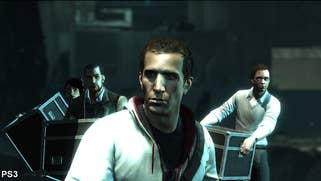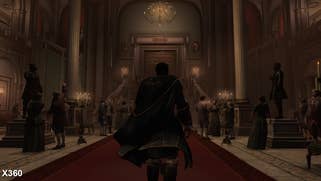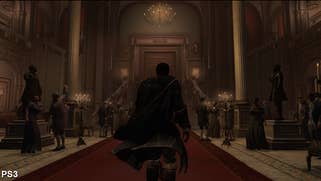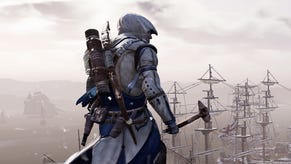Face-Off: Assassin's Creed 3
Naval gazing.
| - | Xbox 360 | PlayStation 3 |
|---|---|---|
| Disc Size | 7.4GB (disc one), 3.9GB (disc two) | 11.46GB |
| Install | 7.4GB (disc one), 3.9GB (disc two) - optional | 4.5GB - mandatory |
| Surround Support | Dolby Digital | Dolby Digital, DTS, 5.1LPCM |
Declaring itself to be one of the very last dinosaurs working on a triple-A game of this scale, Ubisoft's Montreal studio has made no bones about the breadth of Assassin's Creed 3's content. The first shock is at how greatly the play area has been up-sized, where its recreation of an 18th Century America is estimated to be 1.5 times the size of Rome in Brotherhood. This new reality is one of hunting animals in the native wilderness, commandeering ships launched from harbours in Boston and New York, and travelling for miles around the many satellite towns of a nation in revolt.
It's big, and a high risk-reward proposition that can't afford to disappoint. Fortunately the hard work has paid off with a commendable 9/10 Eurogamer score, leaving us with just one matter left to resolve: which version is the best way to enjoy the experience? As it happens, this fifth entry in the series has upped the stakes by offering wider multi-platform support than usual, with PC and Wii U versions pencilled in for the latter-half of November. For now, however, we can turn our analytical eyes to the traditional Face-Off duo: PS3 and Xbox 360.
Each chapter in the Assassin's Creed saga has brought with it a new set of technical improvements for each platform, and this entry adds its fair share. To recap, last year's Revelations may not have pushed the boat out far in the narrative sense, but certainly the richer scenery detail and improved character animations marked clear signs of technical progress. Assassin's Creed 3 carries over all these incremental advances to the new AnvilNext engine, while also bumping up the numbers of concurrent NPCs to a magnitude of hundreds, and adding new weather states to the game world.
So let's crack on and see where things are headed. For those who like to judge visuals in motion, we have a head-to-head video comparing matching footage for both cut-scenes and gameplay alike just below. Alternatively, we have an exhaustive PS3/360 comparison gallery for you to flick through.
"Each chapter in the Assassin's Creed saga has brought with it a new set of technical improvements for each platform, and this entry adds its fair share."
As per series tradition, we're pleased to find that native resolution is once again a non-issue here - we get the full 1280x720 service from each console, which avoids any aliasing issues relating to upscaling. On very close inspection we do spot the PS3 version chopping two horizontal lines of pixels from the very top of its output, but this isn't going to be noticeable across the run of play. Post-process anti-aliasing is the order of the day here too, and, as with Revelations, it appears to avoid any residual texture-blurring associated with a "final pass" approach to smoothing jaggies. This likely rules out FXAA, and puts it in the realm of secretive in-house solutions.
Unfortunately the AA treatment doesn't extend to shadows, which can look very low-grade on snowy floors beneath trees and buildings - though with any luck, the PC version will offer up a few more options here. Also, a dithering effect is evident on shadows at a closer range on PS3, where the transition to higher-quality implementations can play out within your line of sight while walking forward. This is a facet of the 360 version's design too, but the switch-over is less noticeable as a result of the shadow cascade being further afield.
Besides that, every texture asset and effect appears identical between the two platforms, and it's a struggle to parse out any differences. Texture filtering does appear slightly sharper on 360 at a distance, though this isn't to discredit the look on PS3 when played without such a point of comparison. There are also inevitable oddities in the way global illumination affects the lighting of cities during some comparisons - a by-product of the in-game clock and weather effects in play.








Riding a horse at full gallop through bustling cities was always bound to show the limitations of the game's draw distance, and it proves an equal bugbear on either console. NPCs switch in and out on approach, and crates can suddenly fizzle in to the sides of buildings. This also proved a problem in previous games, but is exacerbated by the raised NPC count often in effect here. Thankfully this doesn't crop up around the Frontier's vast woodland areas - sprinting through highlands packed with trees, wildlife, streams and cliffs gives us a perfectly integral image no matter what.
The other major addition is snow effects, plus matching arctic landscapes. The approach to it here is convincingly put forward and applied smartly during gameplay, where certain missions see players tracking down characters by means of snow imprints. The snow crumbles around your knees, and a white haze also drifts over woodlands during these winter sections, adding to an already strong list of atmospheric effects seen in previous games, such as fog, mist, and rain. It looks the part, and neither version misses out.
Assassin's Creed 3: performance analysis
Now onto performance, which has often proven to be the distinguishing point for this series. With the 18th Century American setting, there's a lesser calling for areas as geometrically busy as Brotherhood's recreation of Rome, so instead we have cities and villages sprawled out across a wider field. The world has less verticality than previous Assassin's Creed titles as a result - though there are a few occasional high points to get your bearings from - which has given Ubisoft more breathing room when working within the confines of the 360 and PS3's capabilities.
This overhead bodes well for potential improvements, to either frame-rate or the outside chance of v-sync being engaged. Previously, we've seen full-screen tearing crop up prominently on both consoles when confronted with too much complex scenery, though a little more so on Sony's platform. Here, we put similar footage to our Face Off video through our analysis tools to find out where things might have changed.
"At last, Ubisoft has made sure that there's absolutely no tearing on either platform. It's absent from all the scenes where we'd previously expect it, such as places heavy on fire and smoke effects."
At last, Ubisoft Montreal has made sure that there's absolutely no tearing on either platform. It's absent from all the scenes where we'd previously expect it, such as places heavy on fire and smoke effects, and perhaps best of all, this comes without too great a detriment to performance.
In fact, the frame-rate during like-for-like scenes is seemingly improved over previous entries too. We can see anything from 40FPS peaks while walking across ship masts, to 20FPS troughs when confronted with hundreds of NPCs in a theatre, proving the v-sync setting is hugely adaptable. As a general rule, we do get an ideal 30FPS during cut-scenes around the Boston and Frontier areas. This is the sweet spot for judder-free gameplay as it synchronises to the common 60Hz output of HDTVs, leaving us wishing the lock at this figure was a permanent one.
But which console edges ahead? The 360's performance lead has become less pronounced with each addition to the series and this entry brings us closer still to a neck-and-neck position. Architectural differences in Sony and Microsoft's hardware do bring inherent performance boosts during gameplay clips, however. For PS3, anything involving naval warfare or scenes around the Animus proves far more digestible, giving us up to a five frame lead on average over the 360. By comparison, the 360 excels in a similar way with areas flooded with NPCs. This is taken to an extraordinary extreme in the theatre scene early on, which is packed to the rafters with what appears to be hundreds of characters rendered at once.
Next up, we look at how performance fares during unsynchronised stretches of gameplay. This is an opportunity to test battles against the enforcing British regiments, fast travel by horse-back around forest hill-sides, and also some signature parkour climbs up to high vantage points. We start off with another look at the bustling reception area of the theatre, where we can this time interact with the crowds by pushing through. Again, neither console tears a single frame through thick and thin, and in terms of frame-rate the 360 comes out on top in these instances.
"Frame-rate is unlocked on both platforms leading to additional, unnecessary judder. A 30FPS cap would have synchronised nicely with the 60Hz refresh of HDTVs."
Bizarrely, we can hit an even higher frame-rate threshold when given full control. Climbing the main mast of our ship allows us to hit a peak of 45FPS on either console - likely a result of how little geometry is being rendered outside of the boat itself. Nevertheless, frame-rate appears anchored to the 30FPS line during traversal around woodland on 360, which results in perceptibly smoother motion than the 35FPS values we experience on PS3. Sadly this higher rate isn't compatible with the refresh of most monitors, and we once again see periodic juddering when we pan the camera around.
Confronting the British regiment on the rainy Boston streets gives us our lowest value, at 20FPS for either version, especially once all allies are fully engaged in the swashbuckling. Though soldiers share the same principal model, the higher level of detail in their design compared to the much plainer NPCs does clearly takes its toll here. Controller response dips as a result, which becomes a tricky prospect for a game that rewards you for timed counter attacks. Either way, the majority of battles do get away with 30FPS locked performance, which will be a relief for players who aren't keen on the stealthy approach.
Assassin's Creed 3: The Digital Foundry verdict
In summary, Ubisoft Montreal has taken all the great technical advances offered up by Assassin's Creed Revelations, and has implanted them in a game with a more ambitious tale to tell. On top of that, it brings its own innovations too, showing a real flexibility to the game's underlying engine. The naval battles are a perfectly pitched addition, given the capabilities of each console, and do much to add variety to the gameplay. Similarly, the bumped-up NPC count, new snow effects, and forest sections also elevate the world's sense of scale and atmosphere. Certainly, the complexity of Rome isn't quite matched by Boston's 18th Century manifestation, but this is partly made up for by the added bustle on the harbours, and the constant flux of the weather.
"The differences have once again become even more marginal and either version is worth your attention."
Technically, Assassin's Creed 3 is very well-rounded game on both PS3 and 360. For starters, the use of v-sync does greater justice to the visuals while in motion, where torn frames are now gladly a thing of the past. Outside of differences in texture filtering and shadow draw distance, which favour Microsoft's console by a small margin, there's very little else that set these two versions apart in terms of image quality. The 4.5GB mandatory install on PS3 might be a factor for some, but it's clear that the faster streaming from HDD has benefited performance greatly, resulting in a frame-rate that's often neck-and-neck with the 360's - save for a few busy spots around city areas.
Looking forward, it'll be fascinating to see what may be added - or potentially subtracted - from the game's upcoming Wii U release, and whether tablet controls can find a place in the Assassin's Creed experience. The upcoming PC version will also be worth considering, especially if it allows us to clear up the weaker graphical elements in view on console such as the aliased shadows and visible geometry pop-in. If you can't wait, however, it's fair to say the game is built around a strong familiarity of the 360 and PS3's boundaries, which reaps dividends in every other way. The differences have once again become even more marginal and either version is worth your attention.









